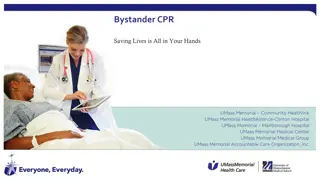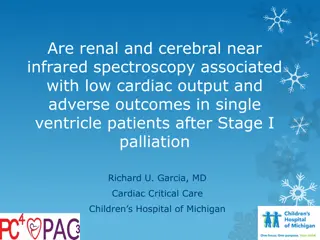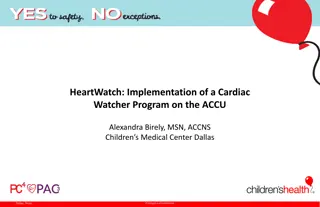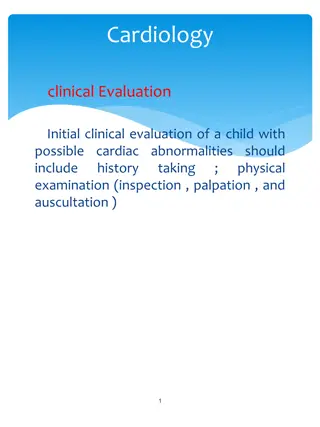Comprehensive Guide on Caring for Children with Cardiac Conditions
This comprehensive guide provides information on cardiac conditions in children, including how the heart works, types of cardiac conditions, treatment options, activity restrictions, and how to respond to congestive heart failure. It covers topics such as infective endocarditis and outlines symptoms to look out for. Additionally, it emphasizes the importance of seeking medical help promptly in case of emergency situations.
Download Presentation

Please find below an Image/Link to download the presentation.
The content on the website is provided AS IS for your information and personal use only. It may not be sold, licensed, or shared on other websites without obtaining consent from the author. Download presentation by click this link. If you encounter any issues during the download, it is possible that the publisher has removed the file from their server.
E N D
Presentation Transcript
Cardiac Conditions Caring for children with cardiac conditions in a community program 2015-07-14
How the Heart Works Collects oxygen-poor blood from body and pumps it to the lungs to get oxygen Pumps blood to the lungs and body by a sequence of organized contractions
Types of cardiac conditions Congenital heart defects Slows down or blocks blood flow in the heart or in the blood vessels near the heart Arrhythmias Abnormal heart beats Genetic cardiac conditions Acquired cardiac conditions Occurs from infection
Treatment Medication Surgery Heart transplant Fontan procedure Pacemaker Internal Cardioverter Defibrillator (ICD)
Activity restrictions Most children with cardiac conditions can participate in physical activities without restrictions For some children, competitive or excessively stressful activities may be restricted
Infective Endocarditis Inflammation caused by an infection in the lining of the heart Caused by bacteria that gets into blood Can lead to permanent damage of the heart May require antibiotics before medical or dental procedure Inform EMS that child has cardiac condition
Congestive Heart Failure Sweating during quiet time Persistently rapid/labored breathing Shortness of breath Rapid heart rate or irregular heart rate Chest pain Nasal flaring Blueness on or around the mouth, eyes, ears, and/or finger tips Listlessness (tired and unwilling to do normal activities) Inability to stop coughing Skin becomes increasingly pale or blue Suddenly tired
Responding to Congestive Heart Failure 1. Have child rest. 2. If condition doesn t improve, contact parent/guardian. 3. If symptoms do not improve and parent/guardian or emergency contact cannot be reached within 5 to 10 minutes, activate 911/EMS. 4. Place child on the floor in recovery position (lying on left side). 5. Keep the airway open. Loosen any tight restrictive clothing. 6. Stay with child until EMS personnel arrive. If the child has noisy gurgled breathing, call 911/EMS.
Loss of consciousness 1. Call 911/EMS. 2. Implement CPR and the use of an automated external defibrillator (AED), if available. 3. Notify the parent/guardian. 4. Inform EMS that the child has a cardiac condition.
Child specific information Type of cardiac condition Activity restrictions Additional information Health Care Plans are located in child file and binder
Syncope Temporary loss of consciousness Passing out or fainting Usually occurs without warning and often during exercise 1. Call 911/EMS. 2. Implement CPR and the use of an automated external defibrillator (AED), if available. 3. Notify the parent/guardian. 4. Inform EMS that the child has a cardiac condition.
Tachycardia Heart rate too fast to count May experience fatigue, dizziness, lightheadedness, chest pain, shortness of breath, upset stomach, weakness
Tachycardia 1. Have the child rest. 2. If symptoms do not improve with rest, contact the parent/guardian. If the symptoms worsen with rest, call 911/EMS immediately. 3. If the parent/guardian or emergency contact cannot be reached, call 911/EMS. 4. Stay with the child until EMS personnel arrive. 5. Inform EMS that the child has a cardiac condition.
Bradycardia Slow heart rate May experience decreased level of activity, weakness, paleness, dizziness 1.Contact parent/guardian. 2.If child's condition does not improve in 20 minutes and you are unable to contact parent/guardian or emergency contact, call 911/EMS.
Pacemakers Battery operated device used to maintain normal heart rhythm May experience bradycardia and syncope Some devices may interfere with the function of the defibrillator Some sports may need to be avoided if they result in a blow to the chest
Internal Cardioverter Defibrillator (ICD) If child experiences an internal shock 1. Put child in recovery position (lying on left side). 2. Ensure child s safety. 3. If child is responsive and received one shock, contact parent/guardian. 4. If parent/guardian or emergency contact cannot be reached, call 911/EMS. 5. If child is not responsive or received more than one shock, call 911/EMS.
Internal Cardioverter Defibrillator (ICD) Battery operated device implanted for in chest or abdomen If ICD is not working and child experiences tachycardia or syncope call 911/EMS Some sports may be restricted if they may result in a blow to the chest Some devices may interfere with the function of the defibrillator
Heart Transplant Anti-rejection drugs 5 minute warm up, 5 minute cool down for vigorous exercise Needs at least 2 litres of water daily Contact parent if child ill or exposed to communicable disease Other precautions Avoid undercooked food Avoid grapefruit Avoid dusty areas, smoke Avoid animals, gardening
Blood thinners External bleeds Mouth bleeds Nose bleeds Surface cuts Internal bleeds Bruising Joint & muscle bleeds Life-threatening bleeds
Surface cuts Nose bleeds Mouth bleeds 1. Put on gloves. 2. Clean skin. 3. Apply firm continuous pressure until bleeding stops. 4. Apply bandage or dressing. 5. Encourage ice. 6. Call parent/guardian if bleeding does not stop after 20 minutes. 7. If unable to reach parent/guardian or emergency contact, call 911/EMS.
Bruising Notify parent/guardian if bruise is increasing in size. Muscle & Joint Bleeds 1. Have child rest. 2. Apply ice to injury. 3. Elevate injured body part. 4. Contact parent/guardian. 5. If unable to contact parent/guardian or emergency contact after 15 minutes, call 911/EMS.
Life-threatening Bleeds If a child has a significant injury to the head, eye, neck, chest or abdomen (with or without signs) 1. Call 911/EMS. 2. Notify parent/guardian.























